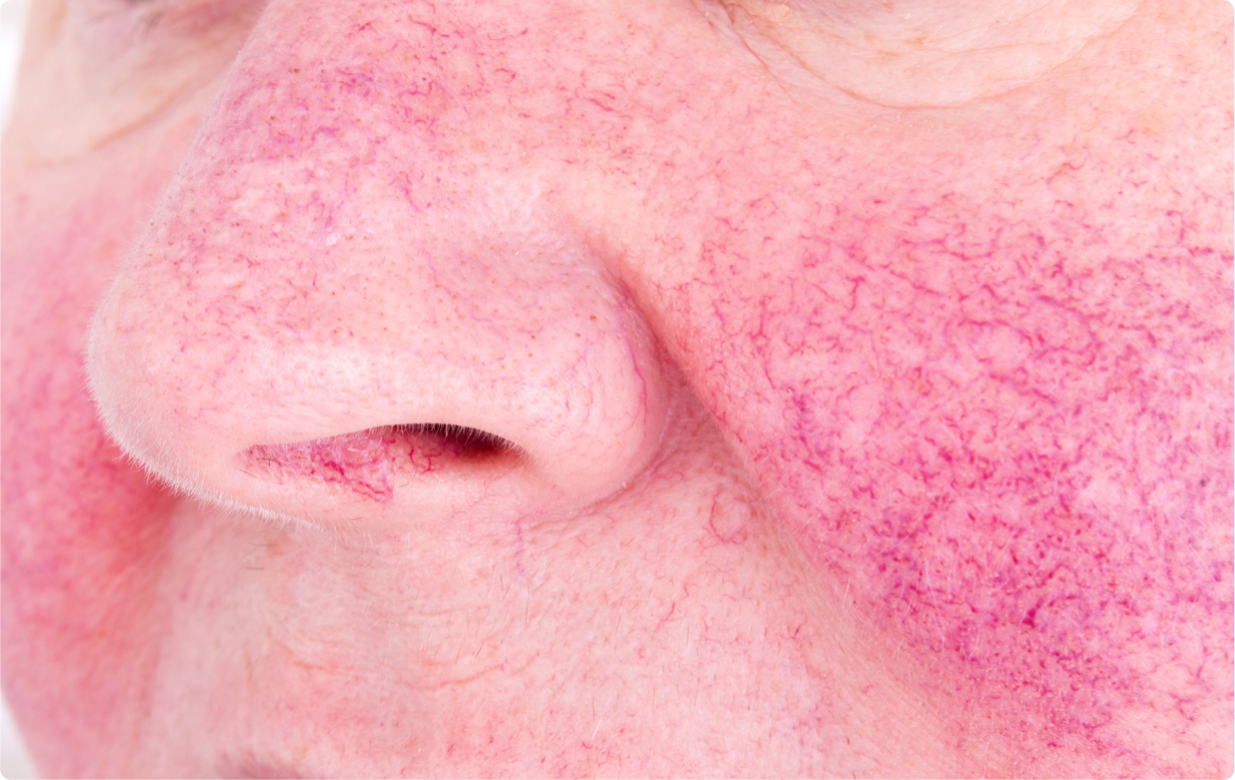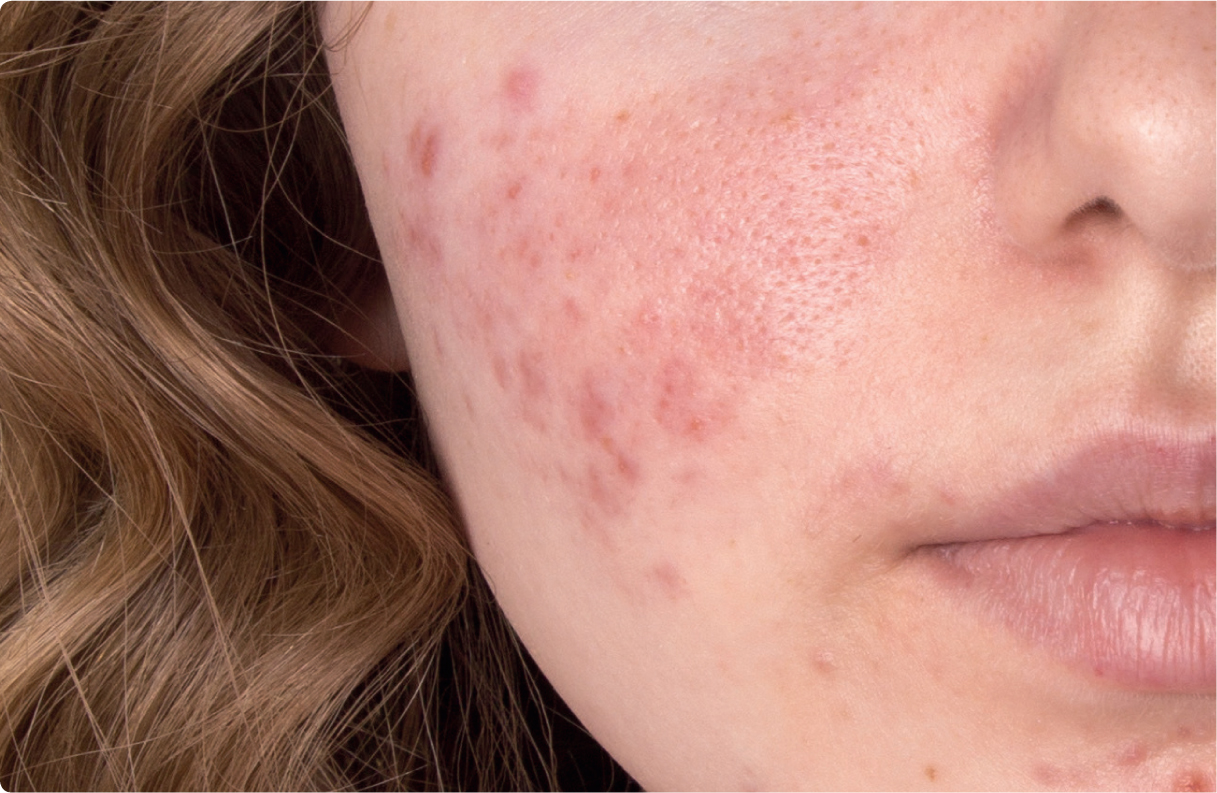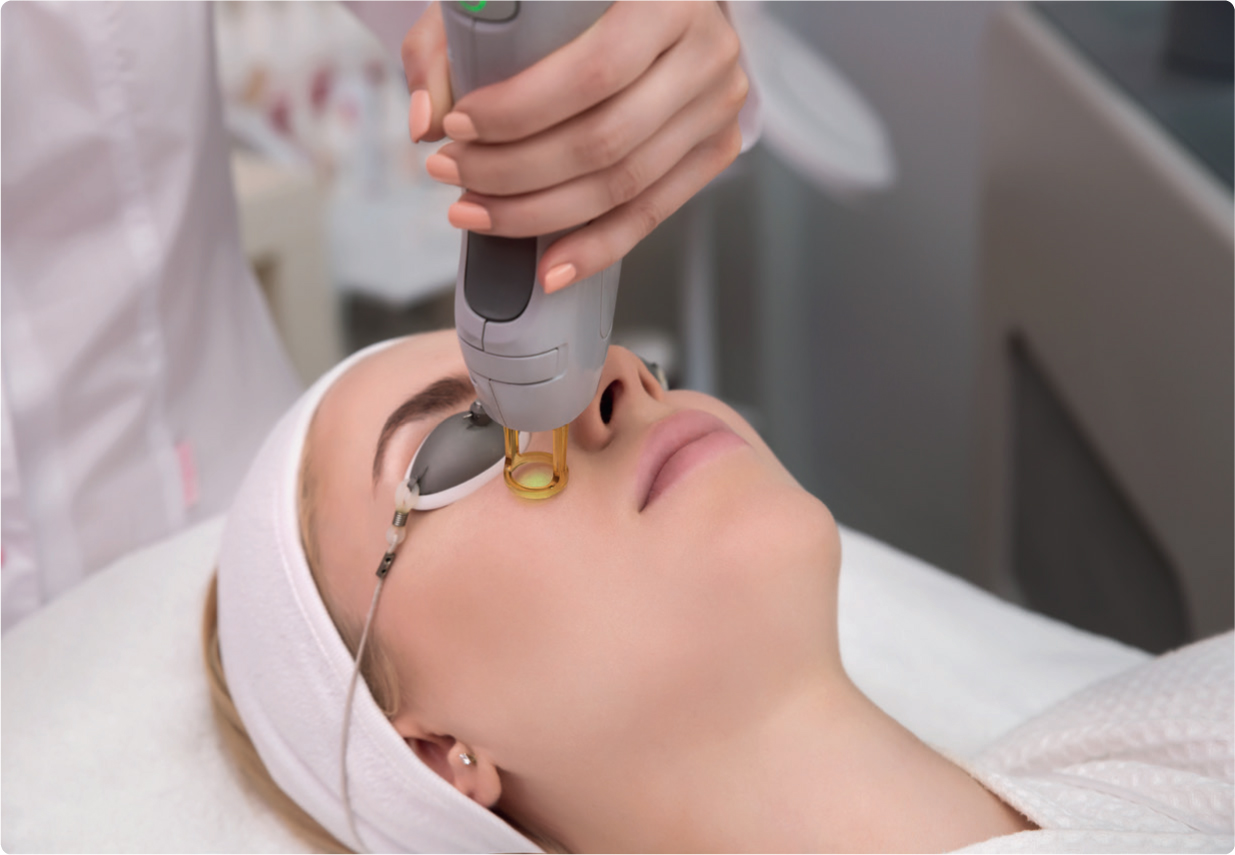
Rosacea is a chronic condition of the skin. There are several different classifications, which makes rosacea a difficult condition to treat. One common symptom of Rosacea is facial flushing, and patients often report that they find this to be one of the most distressing features of the condition. Flushing of the skin is caused by a dysfunction of the neurovascular system, which causes involuntary vasodilatory flushing, generalised redness and erythema, with associated pustules and papules (Wilkin et al, 2002). In addition to this, Steinhoff et al (2016) suggested that there are elements of the immune system that are also involved in the disease process.
Colonisation of the skin is suggested to be another trigger factor in relation to rosacea, with dermidex folliculorum and dermidex brevis being two of the organisms responsible for this. Helicobacter pylori is also suggested to play a role in the disease pathogenesis (Gether et al, 2018).
The diagnosis of rosacea is complex and it is often misdiagnosed—often as acne. Because of this, the treatment given is often either inappropriate or inadequate (Saleem and Wilkin, 2018). Rosacea is not specific to gender; however, individuals with fair skin types (Fitzpatrick scale I, II and III) are more likely to suffer from rosacea (Moustafa et al, 2015).
The prevalence of rosacea in Europe can be anything from 2–22% of the population (Abram et al, 2010). However, the data available are limited and don't take into consideration the amount of people who have rosacea who have either been misdiagnosed or not diagnosed at all. There is wide variation in prevalence across countries; Germany has a prevalence of 12.3%, while Russia has only 5%. There is no simple explanation for the difference in prevalence from country to country (Tan et al, 2016).
Many clients want an almost immediate treatment solution to their rosacea, and they are disappointed when they are told that this is not always possible. Rosacea is a chronic inflammatory condition, and it requires a combination approach that incorporates effective and appropriate medication, a good skin care routine and self-care (Del Rosso, 2014). It is essential that the client is given honest and realistic expectations of the treatment regime that they are embarking upon for the treatment of their rosacea. The overall treatment aim (which should be clearly set out at the outset of treatment) should be focused on the alleviation of symptoms in order to improve the holistic wellbeing of the client. It should be made very clear to the client that there is no current cure for rosacea.
As already eluded to, Johnston et al (2018) argued that it is common for client with rosacea to experience several negative effects on their overall health and wellbeing. This can range from social isolation, avoidance of social events, lowered self-esteem, embarrassment and anxiety. Therefore, an essential element of the management of rosacea should not only focus on the physiological factors, but also on the psychosocial factors that have a negative impact on the patient, in order to provide holistic care.
Classifications and treatments
Erythematotelangiectatic rosacea
Erythematotelangiectatic rosacea is characterised by visible redness, usually in the centre of the face, flushing of the skin and telangiectasia, which is the visible superficial blood vessels on the surface of the skin.
There are several common features that can be seen with this type of rosacea, including rough and scaly presentation of the skin. This is often associated with sensitivity, as well as stinging and burning sensations, and the skin is often very dry in appearance. Erythema-totelangiectatic rosacea is the most common presentation of rosacea (Saleem and Wilkin, 2018). One of the most distressing aspects of this condition for patients is the flushing, which causes physical discomfort and psychological effects, such as lack of confidence (Han et al, 2016).

A common treatment for this is the use of beta blocking medication, such as propranolol 10–40 mg taken three times daily, which works by not only reducing the sympathetic activity associated with flushing, but also by blocking the adrenergic receptors of the smooth muscle within the blood vessels, causing vasoconstriction rather than the associated vasodilation that causes the flushing. An alternative to this is suggested by Cunliffe (2018), who argued that 50 mg clonidine provides relief from facial erythema associated with rosacea.
The use of a pulsed dye laser (PDL) at 595 nm is a standard treatment for erythematotelangiectatic rosacea. Handler et al (2017) investigated the use of intense pulse light (IPL) in place of PDL in the treatment of rosacea, and found that both IPL and PDL are effective treatment modalities for the condition (Handler et al, 2017).
There is an increased number of mast cells in the dermis of the skin of a person with erythematotelangiectatic rosacea (Muto et al, 2014). The role of the mast cell is to recruit other cells from the immune system by evoking an immune response; furthermore, the mast cells are believed to trigger generalised vasodilation and angiogenesis. As well as this, antimicrobial peptides (AMPs) called cathelicidin are found within the cells of the immune system. Their role is to defend against invasion of the body by bacteria, and this is achieved by invoking an inflammatory skin response, which is typical of rosacea (Muto et al, 2014).
Papulopustular rosacea
Papulopustular rosacea is characterised by swelling and redness to the centre of the face, alongside episodes of acne-like skin breakouts. Once of the most common misdiagnoses of papulopustular rosacea is acne vulgaris. However, there are several differences between the two conditions. Notably, there are no comodones in papulopustular rosacea as found in acne vulgaris. Also, the redness is more marked in rosacea with the appearance of areas of ‘plaques’.
As discussed previously, the treatment of the vascular component of rosacea is difficult and is not well understood. Stein et al (2014) suggested that 1% ivermectin cream is a safe and effective treatment for the inflammatory lesions associated with this condition. Metronidazole is also often used as a topical antibiotic to control the pustular element of this condition; however, Elewski et al (2003) suggested that frequently, topical antibiotics are prescribed and the chronic inflammatory process is not taken into account in the treatment of rosacea. Furthermore, topical azelaic acid gel alongside metronidazole gel is much more effective than a topical antibiotic alone (Elewski et al, 2003). The National Institute for Health and Care Excellend (NICE) (2014) stated that the use of brimonidine tartrate gel is effective in the treatment of facial flushing due to its vaso-constrictive and vasostablising properties.
However, this is questioned by Dahl (2014), who suggested that the efficacy of these treatments is questionable due to the fact that there is limited evidence in the form of research into rosacea. Whatever research does exist is usually in the form of randomised controlled trials, or analysis of controlled trials, and this is believed by Dahl to provide limited information and evidence that can be used in the effective treatment of this condition (Dahl, 2014).

An alternative to pharmacological treatment of papulopustular rosacea was put forward by Kim et al (2017), who suggested that laser and light-based therapies can be highly successful in the treatment of rosacea. This study showed that although radiofrequency and PDL were both effective treatments for this condition (with 70% of subjects showing a 50% improvement in the condition, based on appearance, discomfort and lesion count) there was a significant decrease in pustule count when radiofrequency was used. Therefore, Kim et al (2017) suggested that this is a more effective treatment than PDL or topical pharmacological treatments, and radiofrequency should be considered as an alternative treatment for papulopustular rosacea in its own right.
Phymatous rosacea
Phymatous rosacea presents as thickened hypertrophied skin and is commonly seen on the nose, but can also spread to the cheeks, glabella and frontalis. The skin is often very oily and the sebaceous glands are prominent. Phymatous rosacea can often present in conjunction with ocular rosacea or papulopustular rosacea. The main treatment for phymatous rosacea centres around the use of topical antibiotics and azelaic acid, as per the management of papulopustular rosacea (McGregor et al, 2018).
Ocular rosacea
Ocular rosacea can cause the appearance of red, irritated eyelids, with localised swelling. Machalinska et al (2016) described this as ocular erythema along the lid margins with a loss of meibomian gland tissue, which will lead to dryness and irritation to the eye along with associated conditions such as iritis. Gonzalez-Hinojosa et al (2018) suggested that an infestation of demodex—a genus of tiny mites that inhabit the hair follicles of mammals—in the eyelashes was a noted trigger factor in the occurrence of ocular rosacea.
Cyclosporin ophthalmic solution is an effective treatment for ophthalmic rosacea; however, it is noted that adequate time must be allocated for a positive response to treatment, and there is also a high incidence of adverse effects with this treatment modality (van Zuuren et al, 2015).
Psychological impact of rosacea
It is vital for the practitioner to consider that rosacea is a chronic condition that will undoubtedly have a profound effect on the individual's self-confidence. Egeberg et al (2016) suggested that rosacea is associated with a high risk of anxiety disorders and depression, and that this is linked to the severity of the condition. Thompson (2014) further supports this by suggesting that there needs to be more done to address the psychosocial impact of having a conditon such as rosacea, and estimates that a quarter of all patients with the condition will experience psychosocial distress.
For this reason, it is suggested that the focus for treating rosacea is twofold: first, to reduce the physical distress caused by the condition and alleviate the symptoms and second, to improve the self-esteem and manage the social isolation experienced by the individual. Jafferaney and Franca (2015) specifically discussed the use of support groups and meetings as a form of social support that is particularly effective for people with rosacea.

Conclusion
In conclusion, rosacea is a chronic inflammatory dermatological condition of relatively unknown aetiology. It presents challenges to aesthetic practitioners in terms of diagnosis, appropriate treatment and management. Treatment is focused on the relief of symptoms and reduction in severity rather than taking a curative approach, and the chronicity of the condition must be considered. Different presentations of the condition require targeted individual treatment, and psychosocial factors must be taken into account when assessing and treating the individual holistically.


